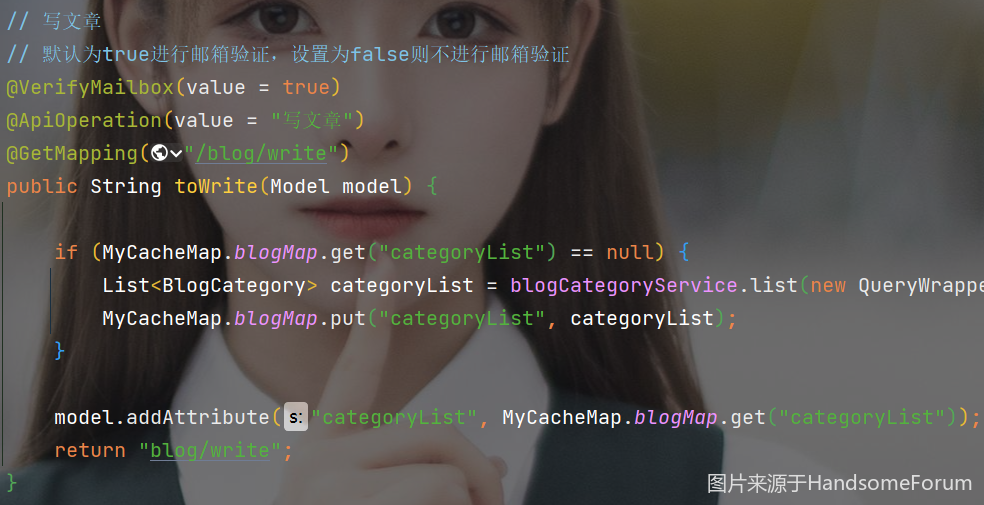
使用AOP实现自定义注解以及获取用户请求IP
使用AOP实现自定义注解功能1.先导入AOP依赖2.编写一个注解3.使用AOP对注解进行增强 完成验证邮箱的逻辑4.在需要进行邮箱验证的方法上添加自定义注解@VerifyMailbox(value = true)表示需要进行邮箱验证@VerifyMailbox(value = false)表示不需要进行邮箱验证使用AOP对controller方法进行增强使用IP工具类获取用户请求IP我的学习论坛.
·
文章目录
AOP方法的执行顺序
package com.handsome.aop;
import lombok.extern.slf4j.Slf4j;
import org.aspectj.lang.ProceedingJoinPoint;
import org.aspectj.lang.annotation.*;
import org.springframework.stereotype.Component;
/**
* @Author Handsome
* @Date 2022/7/2 11:58
* @Version 1.0
*/
@SuppressWarnings({"all"})
@Aspect
@Component
@Slf4j
public class AopTest {
// 定义切入点
@Pointcut(value = "execution( public * com.handsome.controller.*.*(..))")
public void myPointcut() {
}
@Before("myPointcut()")
public void before() {
System.out.println("@Before");
}
@After("myPointcut()")
public void after() {
System.out.println("@After");
}
@Around("myPointcut()")
public Object around(ProceedingJoinPoint joinPoint) throws Throwable {
Object obj = null;
System.out.println("before @Around");
obj = joinPoint.proceed();
System.out.println("after @Around");
return obj;
}
@AfterReturning("myPointcut()")
public void afterReturn() {
System.out.println("@AfterReturning");
}
@AfterThrowing("myPointcut()")
public void afterThrowing() {
System.out.println("抛出异常~");
}
}
执行结果
before @Around
@Before
@AfterReturning
@After
after @Around
使用AOP实现自定义注解功能
1.先导入AOP依赖
<!-- aop依赖 -->
<dependency>
<groupId>org.springframework.boot</groupId>
<artifactId>spring-boot-starter-aop</artifactId>
</dependency>
2.编写一个注解
package com.handsome.aop;
import java.lang.annotation.*;
/**
* @Author Handsome
* @Date 2022/6/22 9:20
* @Version 1.0
*/
@SuppressWarnings({"all"})
// Tpye Method代表可以放在方法上
@Target({ElementType.METHOD})
@Retention(RetentionPolicy.RUNTIME)
@Documented
public @interface VerifyMailbox {
boolean value() default true;
}
3.使用AOP对注解进行增强 完成验证邮箱的逻辑
package com.handsome.aop;
import com.baomidou.mybatisplus.core.conditions.query.QueryWrapper;
import com.handsome.pojo.User;
import com.handsome.service.VerifyMailboxService;
import com.handsome.utils.MyCacheMap;
import lombok.extern.slf4j.Slf4j;
import org.aspectj.lang.ProceedingJoinPoint;
import org.aspectj.lang.annotation.Around;
import org.aspectj.lang.annotation.Aspect;
import org.aspectj.lang.annotation.Pointcut;
import org.aspectj.lang.reflect.MethodSignature;
import org.springframework.beans.factory.annotation.Autowired;
import org.springframework.stereotype.Component;
import org.springframework.web.context.request.RequestContextHolder;
import org.springframework.web.context.request.ServletRequestAttributes;
import javax.servlet.http.HttpServletRequest;
import javax.servlet.http.HttpSession;
import java.lang.reflect.Method;
/**
* @Author Handsome
* @Date 2022/6/22 9:22
* @Version 1.0
*/
@SuppressWarnings({"all"})
@Aspect // 切面 定义了通知和切点的关系
@Component
@Slf4j
public class VerifyMailboxAOP {
@Autowired
VerifyMailboxService verifyMailboxService;
@Pointcut(value = "@annotation(com.handsome.aop.VerifyMailbox)")
public void myAnnotationPointcut() {
}
// 环绕通知 对方法进行增强
@Around("myAnnotationPointcut()")
public Object aroundPointcut(ProceedingJoinPoint pjp) {
MethodSignature methodSignature = (MethodSignature) pjp.getSignature();
Method method = methodSignature.getMethod();
VerifyMailbox verifyMailbox = method.getAnnotation(VerifyMailbox.class);
boolean value = verifyMailbox.value();
if (value) {
// 获取请求信息
HttpServletRequest request = ((ServletRequestAttributes) RequestContextHolder.getRequestAttributes()).getRequest();
// 获取请求用户的session
HttpSession session = request.getSession();
// 获取请求用户的信息
User user = (User) session.getAttribute("loginUser");
// 获取用户的角色Id
Integer roleId = user.getRoleId();
// 判断是否为普通用户,是则需要验证,否则则不需要验证
if (roleId == 2) {
// 进行邮箱验证
// System.out.println("进行邮箱验证~");
// 获取用户ID
String userUid = user.getUid();
// 去map中查是否验证
String success = (String) MyCacheMap.verifySuccessMap.get(userUid);
if (success == null) {
// 根据用户Uid去验证邮箱表查看是否验证
com.handsome.pojo.VerifyMailbox daoUser = verifyMailboxService.getOne(new QueryWrapper<com.handsome.pojo.VerifyMailbox>().eq("uid", userUid));
if (daoUser == null) {
// 未验证则返回去验证页
return "verify/verify";
} else {
// 存放用户验证成功的UID
MyCacheMap.verifySuccessMap.put(userUid, "Success");
}
}
// 已验证则继续进行原操作
} else {
// System.out.println("站长或管理员无需验证,直接放行~");
}
} else {
// 直接放行
// System.out.println("未开启邮箱验证,直接放行~");
}
// 调用方法
Object obj = null;
try {
obj = pjp.proceed();
} catch (Throwable e) {
// 获取方法类名
String classNameError = pjp.getTarget().getClass().toString();
// 获取方法名
String methodNameError = pjp.getSignature().getName();
log.error("在" + classNameError + "的" + methodNameError + "中,发生了异常:{}", e);
return e.getMessage();
}
return obj;
}
}
4.在需要进行邮箱验证的方法上添加自定义注解

5.自定义注解说明
@VerifyMailbox(value = true)表示需要进行邮箱验证
@VerifyMailbox(value = false)表示不需要进行邮箱验证
使用AOP获取用户请求IP
1.编写获取请求用户IP的工具类
package com.handsome.utils;
import lombok.extern.slf4j.Slf4j;
import javax.servlet.http.HttpServletRequest;
import java.net.InetAddress;
/**
* @Author Handsome
* @Date 2022/6/7 11:09
* @Version 1.0
*/
@SuppressWarnings({"all"})
@Slf4j
public class IPAddressUtils {
/**
* 获取IP地址
*/
public static String getIpAdrress(HttpServletRequest request) {
String ipAddress = request.getHeader("X-Forwarded-For");
if (ipAddress == null || ipAddress.length() == 0 || "unknown".equalsIgnoreCase(ipAddress)) {
ipAddress = request.getHeader("Proxy-Client-IP");
}
if (ipAddress == null || ipAddress.length() == 0 || "unknown".equalsIgnoreCase(ipAddress)) {
ipAddress = request.getHeader("WL-Proxy-Client-IP");
}
if (ipAddress == null || ipAddress.length() == 0 || "unknown".equalsIgnoreCase(ipAddress)) {
ipAddress = request.getRemoteAddr();
if ("127.0.0.1".equals(ipAddress) || "0:0:0:0:0:0:0:1".equals(ipAddress)) {
// 根据网卡取本机配置的IP
InetAddress inet = null;
try {
inet = InetAddress.getLocalHost();
} catch (Exception e) {
log.error("根据网卡获取本机配置的IP异常=>", e.getMessage());
}
if (inet.getHostAddress() != null) {
ipAddress = inet.getHostAddress();
}
}
}
// 对于通过多个代理的情况,第一个IP为客户端真实IP,多个IP按照','分割
if (ipAddress != null && ipAddress.length() > 15) {
if (ipAddress.indexOf(",") > 0) {
ipAddress = ipAddress.substring(0, ipAddress.indexOf(","));
}
}
return ipAddress;
}
}
2.使用AOP对controller方法进行增强
// 定义切入点
@Pointcut(value = "execution( public * com.handsome.controller.*.*(..))")
public void myPointcut() {
}
3.使用IP工具类获取用户请求IP
// 环绕通知
@Around("myPointcut()")
public Object myLogger(ProceedingJoinPoint pjp) throws Throwable {
String userIP = null;
try {
// 获取请求信息
HttpServletRequest request = ((ServletRequestAttributes) RequestContextHolder.getRequestAttributes()).getRequest();
// 获取请求用户IP
userIP = IPAddressUtils.getIpAdrress(request);
if (userIP == null) {
return "error/limit";
}
} catch (Exception e) {
log.error("获取request出错=>" + e.getMessage());
}
}
我的学习论坛
HandsomeForum:用Java编写的学习论坛,打造我们自己的圈子!(http://huangjunjie.vip:66)
文章链接(使用AOP实现自定义注解功能):http://huangjunjie.vip:66/blog/read/ua4ejo4uc8ixifglao
文章链接(使用AOP获取请求用户IP):http://huangjunjie.vip:66/blog/read/y7zla1vyebmhyjecli
更多推荐
 已为社区贡献3条内容
已为社区贡献3条内容









所有评论(0)